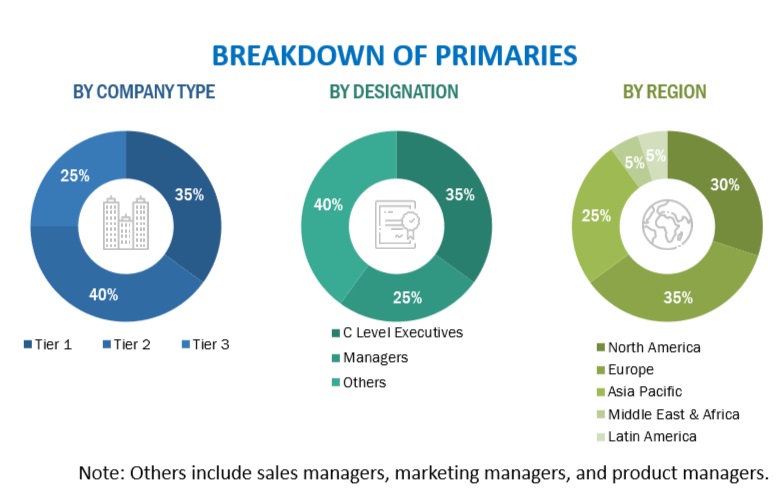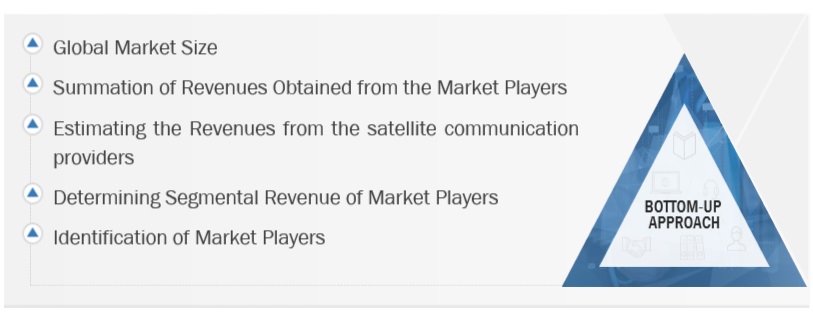This research study involved extensive secondary sources, directories, and databases, such as Dun & Bradstreet (D&B) Hoovers and Bloomberg BusinessWeek, to identify and collect valuable information for a technical, market-oriented, and commercial study of the satellite communication market. The primary sources have been mainly industry experts from the core and related industries and preferred suppliers, manufacturers, distributors, service providers, technology developers, alliances, and organizations related to all segments of the value chain of this market. In-depth interviews have been conducted with various primary respondents, including key industry participants, subject matter experts, C-level executives of key market players, and industry consultants, to obtain and verify critical qualitative and quantitative information.
Secondary Research
The market for companies offering satellite communication solutions and services to different verticals has been estimated and projected based on the secondary data made available through paid and unpaid sources and by analyzing their product portfolios in the ecosystem of the satellite communication market. It also involved rating company products based on their performance and quality. In the secondary research process, various sources such as the International Journal of Satellite Communications and Networking (IJSCN), the International Journal of Remote Sensing, and the Einstein International Journal Organization (EIJO) have been referred to for identifying and collecting information for this study on the market. The secondary sources included annual reports, press releases, investor presentations of companies, white papers, journals, certified publications, and articles by recognized authors, directories, and databases. Secondary research has been mainly used to obtain essential information about the supply chain of the market, the total pool of key players, market classification, segmentation according to industry trends to the bottommost level, regional markets, and key developments from both market- and technology-oriented perspectives that primary sources have further validated.
Primary Research
In the primary research process, various primary sources from both the supply and demand sides were interviewed to obtain qualitative and quantitative information on the market. The primary sources from the supply side included various industry experts, including Chief Experience Officers (CXOs); Vice Presidents (VPs); directors from business development, marketing, and product development/innovation teams; related critical executives from satellite communication service vendors, SIs, professional service providers, and industry associations; and key opinion leaders. Primary interviews were conducted to gather insights, such as market statistics, revenue data collected from services, market breakups, market size estimations, market forecasts, and data triangulation. Primary research also helped in understanding various trends related to technologies, applications, deployments, and regions. Stakeholders from the demand side, such as Chief Information Officers (CIOs), Chief Technology Officers (CTOs), Chief Strategy Officers (CSOs), and end users using satellite communication services, were interviewed to understand the buyer’s perspective on suppliers, products, service providers, and their current usage of satellite communication services which would impact the overall satellite communication market.

To know about the assumptions considered for the study, download the pdf brochure
Market Size Estimation
Multiple approaches were adopted to estimate and forecast the size of the satellite communication market. The first approach involves estimating market size by summing up the revenue generated by companies through the sale of satellite communication offerings.
Both top-down and bottom-up approaches were used to estimate and validate the total size of the satellite communication market. These methods were extensively used to estimate the size of various segments in the market. The research methodology used to estimate the market size includes the following:
-
Key players in the market have been identified through extensive secondary research.
-
In terms of value, the industry’s supply chain and market size have been determined through primary and secondary research processes.
-
All percentage shares, splits, and breakups have been determined using secondary sources and verified through primary sources.
Market Size Estimation Methodology-Bottom-up approach

To know about the assumptions considered for the study, Request for Free Sample Report
Market Size Estimation Methodology-Top-Down Approach

Data Triangulation
After arriving at the overall market size, the satellite communication market was divided into several segments and subsegments. A data triangulation procedure was used to complete the overall market engineering process and arrive at the exact statistics for all segments and subsegments, wherever applicable. The data was triangulated by studying various factors and trends from the demand and supply sides. Along with data triangulation and market breakdown, the market size was validated by the top-down and bottom-up approaches.
Market Definition
Satellite communication is a method of transmitting and receiving data, voice, and video signals through artificial satellites orbiting the Earth. It enables long-distance communication, reaching remote or underserved areas, and provides global coverage, reliability, and flexibility. Satellites act as relay stations, receiving and retransmitting signals between ground stations, mobile devices, or other satellites.
Key Stakeholders
-
Satellite Operators
-
Service Providers
-
Equipment Manufacturers
-
Telecommunication Companies
-
Regulatory Bodies
-
Satellite Network Integrators and System Integrators End Users
Report Objectives
-
To determine, segment, and forecast the satellite communication market by type, application, end user, and region in terms of value
-
To forecast the size of the market segments concerning 5 main areas: North America, Europe, Asia Pacific, Middle East & Africa, and Latin America
-
To provide detailed information about the major factors (drivers, restraints, opportunities, and challenges) influencing the market's growth.
-
To study the complete value chain and related industry segments and perform a value chain analysis of the market landscape
-
To strategically analyze the macro and micro-markets with respect to individual growth trends, prospects, and contributions to the total market
-
To analyze the industry trends, pricing data, patents, and innovations related to the market
-
To analyze the opportunities for stakeholders by identifying the high-growth segments of the market
-
To profile the key players in the market and comprehensively analyze their market share/ranking and core competencies
-
To track and analyze competitive developments, such as mergers & acquisitions, product launches & developments, partnerships, agreements, collaborations, business expansions, and R&D activities
Available Customizations
With the given market data, MarketsandMarkets offers customizations as per the company’s specific needs. The following customization options are available for the report:
Country-wise information
-
Analysis for additional countries (up to five)
Company Information
-
Detailed analysis and profiling of additional market players (up to 5)



Growth opportunities and latent adjacency in Satellite Communication Market